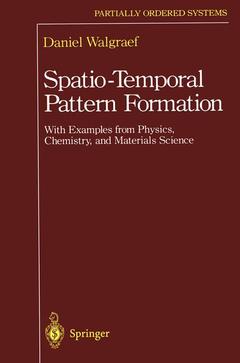Spatio-Temporal Pattern Formation, 1997 With Examples from Physics, Chemistry, and Materials Science Partially Ordered Systems Series
Langue : Anglais

Spatio-temporal patterns appear almost everywhere in nature, and their description and understanding still raise important and basic questions. However, if one looks back 20 or 30 years, definite progress has been made in the modeling of insta bilities, analysis of the dynamics in their vicinity, pattern formation and stability, quantitative experimental and numerical analysis of patterns, and so on. Universal behaviors of complex systems close to instabilities have been determined, leading to the wide interdisciplinarity of a field that is now referred to as nonlinear science or science of complexity, and in which initial concepts of dissipative structures or synergetics are deeply rooted. In pioneering domains related to hydrodynamics or chemical instabilities, the interactions between experimentalists and theoreticians, sometimes on a daily basis, have been a key to progress. Everyone in the field praises the role played by the interactions and permanent feedbacks between ex perimental, numerical, and analytical studies in the achievements obtained during these years. Many aspects of convective patterns in normal fluids, binary mixtures or liquid crystals are now understood and described in this framework. The generic pres ence of defects in extended systems is now well established and has induced new developments in the physics of laser with large Fresnel numbers. Last but not least, almost 40 years after his celebrated paper, Turing structures have finally been ob tained in real-life chemical reactors, triggering anew intense activity in the field of reaction-diffusion systems.
1 Introduction.- 2 Instabilities and Patterns in Hydrodynamical Systems.- 2.1 Rayleigh-Bénard instability.- 2.2 Taylor-Couette instability.- 2.3 Liquid crystal instabilities.- 3 Instabilities and Patterns in Reaction-Diffusion Systems.- 3.1 Chemical instabilities.- 3.2 Defect microstructures in irradiated materials.- 3.3 Plastic deformation and dislocation patterns.- 4 Generic Aspects of Pattern-Forming Instabilities.- 4.1 Phenomenology.- 4.2 Reaction-diffusion dynamics and stability.- 4.3 Reduced dynamics and amplitude equations.- 4.4 Spatial patterns: selection and stability.- 4.5 Phase dynamics of periodic patterns.- 5 The Hopf Bifurcation and Related Spatio-Temporal Patterns.- 5.1 The generic aspects of oscillatory media.- 5.2 Real chemical systems and the complex Ginzburg-Landau equation.- 5.3 The effect of natural forcings on chemical oscillators.- 5.4 Conclusions.- 6 The Turing Instability and Associated Spatial Structures.- 6.1 The Turing mechanism.- 6.2 The search for Turing structures.- 6.3 At last, genuine Turing structures?.- 6.4 The interaction between Turing and Hopf instabilities.- 7 Defects and Defect Bifurcations.- 7.1 Generic existence of defects.- 7.2 Examples of defects.- 7.3 Defects and disorder.- 7.4 Bifurcation of defects.- 8 The Effect of External Fields.- 8.1 Spatial forcing of stationary patterns.- 8.2 Temporal forcing of a Hopf bifurcation.- 8.3 Temporal forcing of one-dimensional wave patterns.- 8.4 Temporal forcing of two-dimensional wave patterns.- 8.5 Spatial forcing of wave patterns.- 8.6 Flow field effects on pattern forming instabilities.- 8.7 The effect of noise on wave patterns.- 8.8 Conclusions.- 9 Fronts.- 9.1 One-dimensional aspects.- 9.2 Two-dimensional aspects.- 10 Pattern Formation: Generic versus Nongeneric Aspects.- 10.1Kinetic coefficients.- 10.2 Nongradient dynamics.- 10.3 Experimental set-ups.- 11 Microstructures in Irradiated Materials.- 11.1 Particle irradiation of metals and alloys.- 11.2 Laser induced deformation of surfaces.- 12 Plastic Instabilities.- 12.1 Dislocation dynamics and rate equations.- 12.2 Stability analysis and bifurcations.- 12.3 Nonlinear analysis.- 12.4 Multiple slip.- 13 Afterword.- 14 Appendices.- 14.1 Bifurcations and normal forms.- 14.2 More about dynamical models.- 14.3 The Brusselator: A toy model for pattern formation in RD systems.- 14.4 Resonant forcings of nonlinear oscillators.
This book provides an interdisciplinary presentation of the current knowledge of pattern formation in complex system, with sufficiently many details, tools, and concrete examples to be useful for the graduate student or scientist entering this area of research.
Date de parution : 09-2012
Ouvrage de 306 p.
15.5x23.5 cm
Disponible chez l'éditeur (délai d'approvisionnement : 15 jours).
Prix indicatif 52,74 €
Ajouter au panierThème de Spatio-Temporal Pattern Formation :
Mots-clés :
deformation; equation; instability; plastic deformation; stability
© 2024 LAVOISIER S.A.S.


